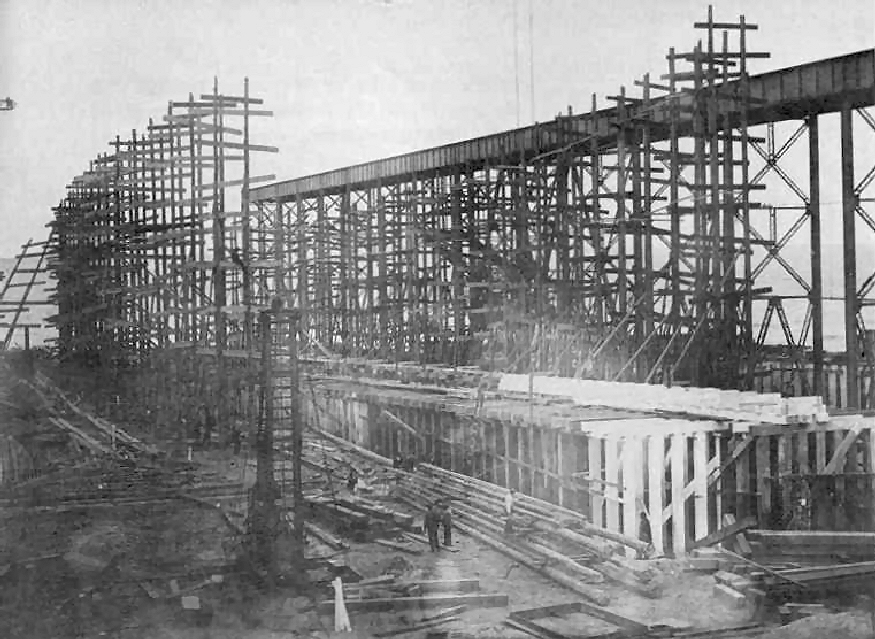
.
.
| Construction Approval to Commission
4 June 1910 to 12 March 1914 |
| Approval to Keel Laying: 24 June 1910 to 17 April 1911 |
One of the first actions after President Taft's 24 June 1910 approval of the US Navy appropriation bill was creating the design plans.
The 29 September 1910 contract plans were the first images
of what she would become.
The contract bidding began 27 Sept 1910.with Newport News Shipbuilding
and Dry Dock Company (NNS), Newport News, Virginia, winning the
contract. The construction contract was signed 17 Dec 1910, for a price
of $5,830,000. The price did not include the armor and armament. The
contract called for a three build period, with a completion date of 17
December 1913. The contract plans were delivered to NNS on 24 December
and the first hull materials were ordered on the 27th.
Before the contract was signed, a major change to the ship's design was
made in early December when the originally intended 32,000hp turbine with
quadruple propellers was replaced with two steam reciprocating engines
with each having one propeller. The fuel efficiency of the turbine at
cruise speed was worse than the reciprocating and the reliability of the
turbines was of concern.
The name "Texas" was assigned to battleship
35 on 16 February 1911, via special order 88.
As of 3 April 1911
 |
| Building The Hull: 17 April 1911 to 18 May 1912 |
| The construction of hull #147 started 17 April
1911 with the laying of the keel and ended 425 days later with the
launching on 18 May 1912 The keel laying was immediately followed by the
erection of the first of the 141 frames made by Carnegie on the 21st.
The first armor was received and installed on 7 August, for Central
Station. On the hull's exterior, a layer of teak wood was installed
where the armor would be located. The last major hull work prior to
launch was installing the white pine-filled rudder, on 14 May 1912.
During construction, horse drawn wagons and wooden scaffolding were
used. Three of the hull's nine layers of paint was applied 2 - red lead 1 - anti-corrosive . Though TEXAS had many state of the art features, old terminology descriptions were still used. In a throw back to wooden ships with cannons lining the lower deck. 2nd deck was labeled as "Gun Deck" on the 29 September 1910 contract plans for 5inch guns were to placed almost the full length of 2nd deck. As of 2 October 1911: The worker in the foreground is on the level above Steering Room-Steering Gear. To the left of him is "H-147", the designation for BB35 at this time 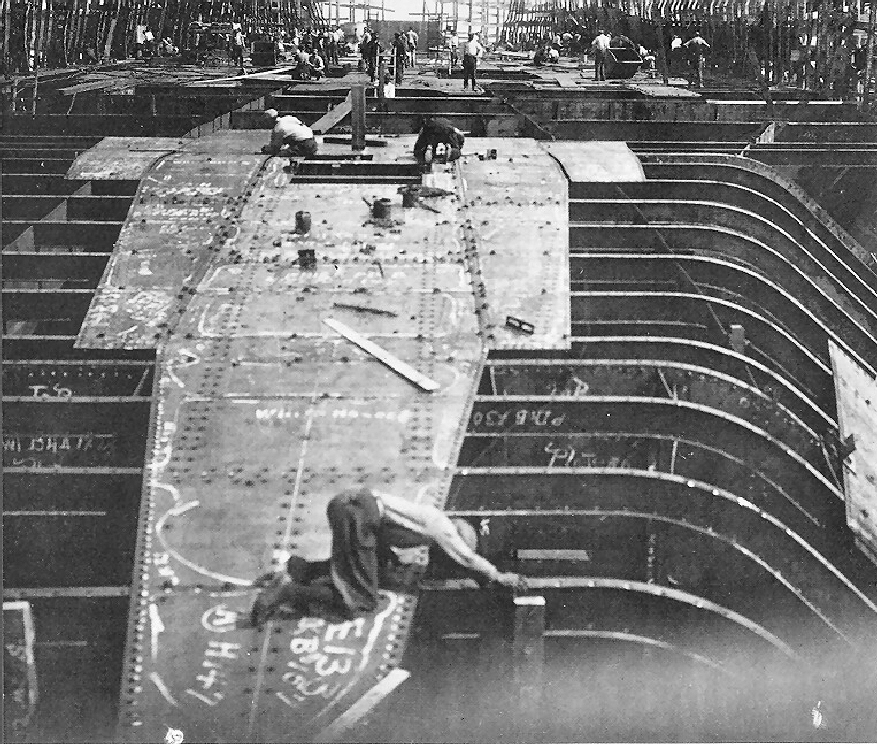 |
|
| |
|
| Launching: 18 May 1912 |
| Launched on 18 May 1912, TEXAS was sponsored by
Miss Claudia Lyon, of Texas. The choice of Miss Lyon by the Secretary of the Navy
created controversy in Texas and Washington DC because Miss Lyon's
father was an important person in the Republican Party in Texas and
congressional members were Democrats. In addition, the temperance union
asked that a bottle of champagne not be used. (A bottle of champagne was
used). The New York Times coverage of the launch reflects the influences
of the time, such a protection as compared to the Titanic. |
| The two torpedo tube openings are visible.
Above the light colored hull area is a layer of wood over which armor will be placed. |
Ms. Claudia Lyon | |||
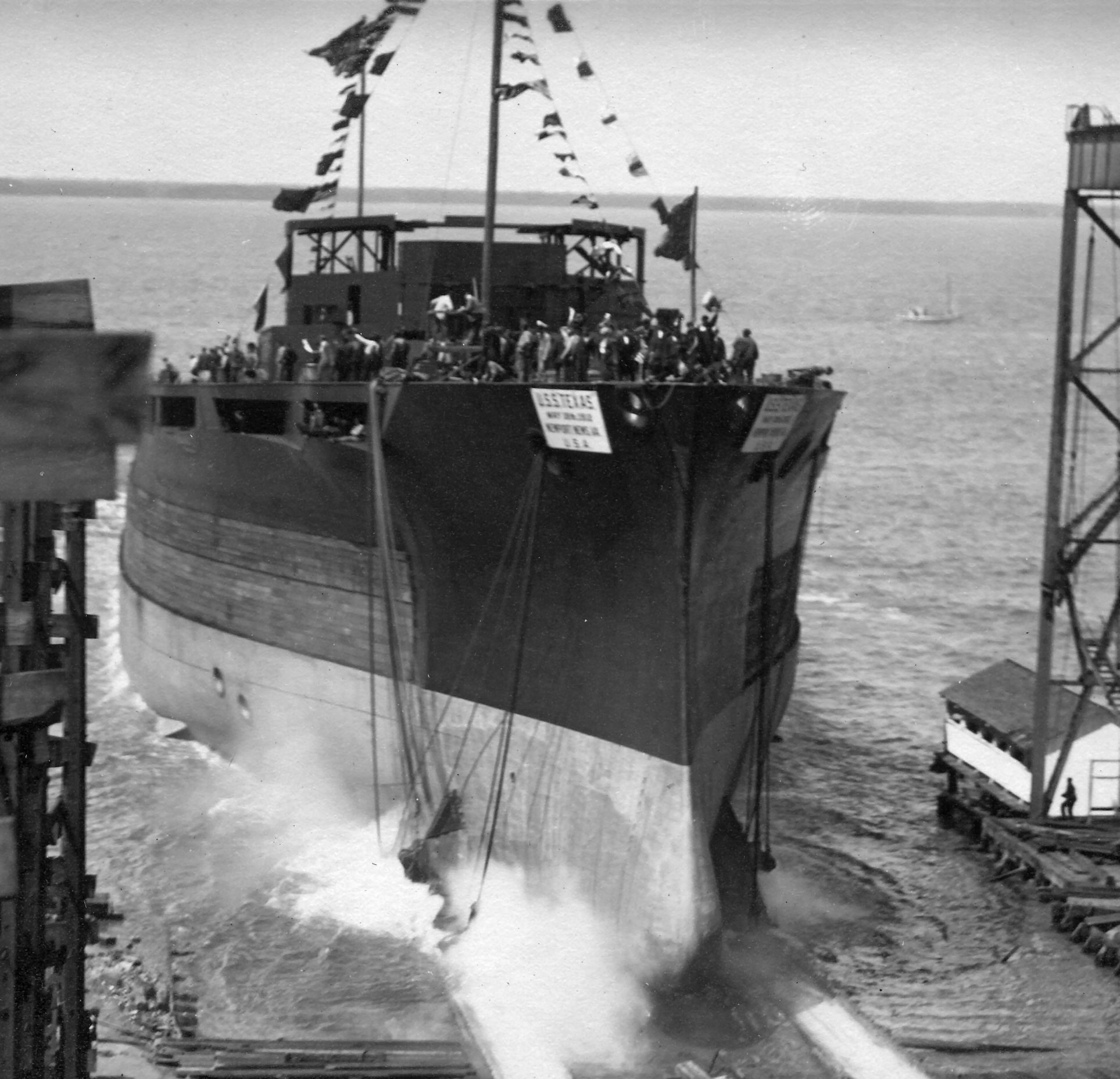 |
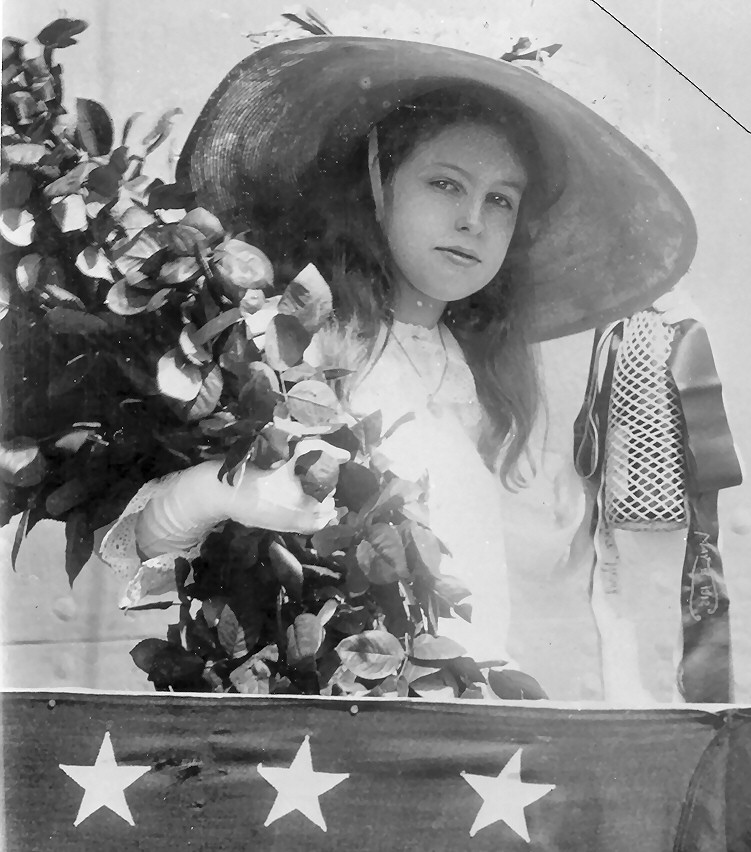 |
|||
| Outfitting: 18 May 1912 to 12 March 1914 | ||
|
The outfitting started with the 18 May 1912 launching and finished 532
day later with the commissioning on 12 March 1914. The outfitting
including the installation of various systems inside the ship, armor
plate on the hull and structures on the main deck and above. The
internal outfitting of hundreds of compartments are reflected in the
1912 joiner plans. Among the details shown: ***Storage of champagne and claret glasses in the Ward Room Officer's Pantry ***Torpedo Rooms showing stowage location of the torpedoes and the location of the torpedo tubes ***A 3rd deck compartment near the bow labeled "Aviation Room" but not details. ***The Captain's Cabin having a 42 inch brass bed and bath tub. Six of the nine hull paintings was done during three periods in the Norfolk Navy Yard ***3 September 1912: 1 anti-corrosive, 1 anti-fouling ***9 April 1913: 1 anti-corrosive, 1 anti-fouling ***29 September 1913: 1 anti-corrosive, 1 anti-fouling Armament installation was in 1913 with the first turret structure installed on 22 February with the first 14inch/45caliber Mark I gun on 5 March. The first of twenty-one 5inch/51caliber guns was installed on 5 August. All guns were installed before leaving NNS for Rockland, Maine, on 19 October 1913, for her speed trials. |
||
| 2 October 1912 At a Newport News outfitting pier | |
 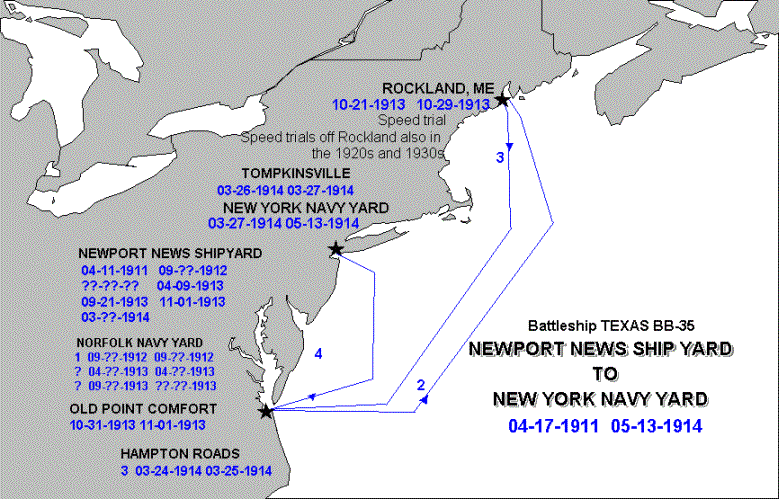 |
| Sea Trials: Rockland Maine 21 to 29 October 1913 |
| Enroute to Rockland, a 50 mile per hour gale was encountered yet maintained an average speed of 19 knots. Maximum speed of 22.28 knots (25.5mph) was obtain, which was also the fastest speed in the ships history. The top of the main mast was not compete at this time. |
| ... |
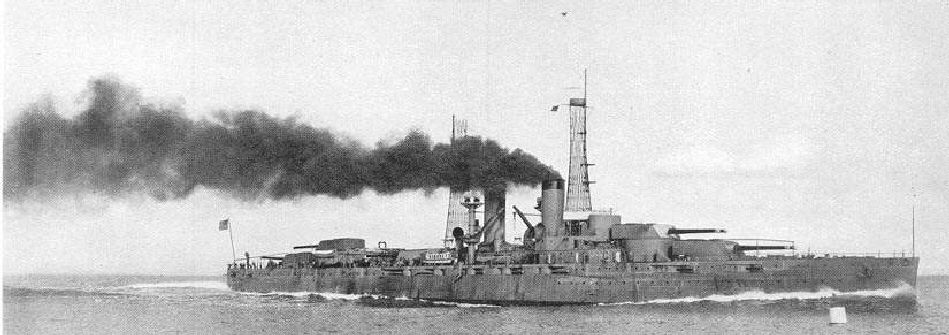 |
After the speed trials, the main mast top was completed and the searchlights installed on two-tiered on both masts. The final parts of the outfitting was a 21 February 1914 final inclining experiment to determine her buoyancy properties and the installation of the last armored plate on 10 March 1914. |
| Commissioning: 12 March 1914 | ||
As 12 March 1914 Note the absence of the opening on the front side of Turret 2 and Turret 4 for the gun directors. The needed openings made and gun directors installed in the New York Navy Yard, 27 March to 13 May 1914. |
||
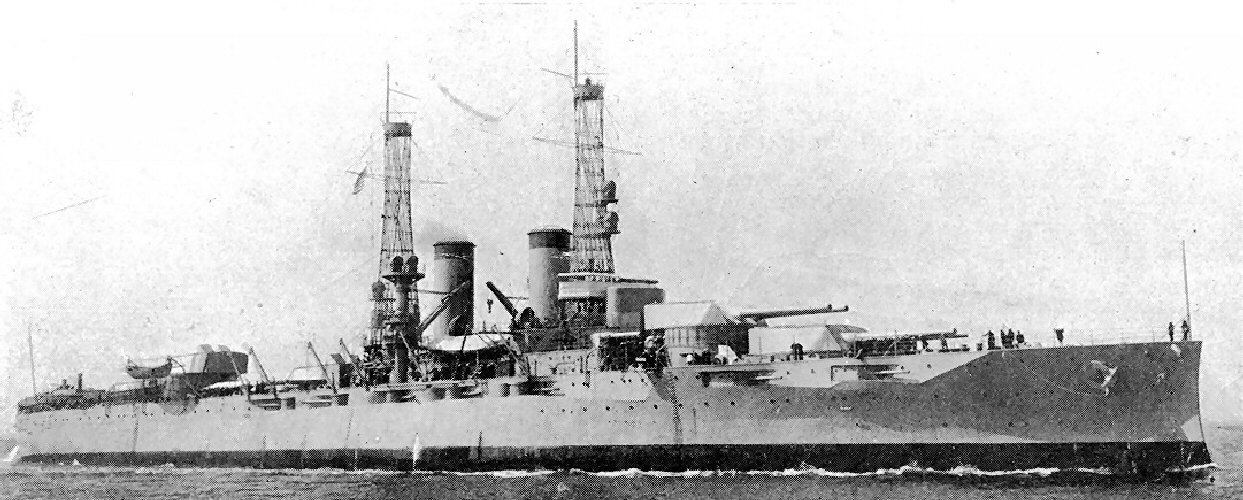 |
|
|
2,850 miles sailed. The most powerful ship in existence being the first ship to have 14inch guns. The New York Times described the 14"/ 45
caliber guns as "Monster Guns" and cost $777 to fire each of the 10
guns. Construction took 1060 days, which was 213
days below the average for all 57 completed battleships and the MAINE
and TEXAS of the 1890s. Among her many modern systems were electric ovens in the galleys, which the New York Times devoted an entire article to. BB35 was also the first US battleship built with a
laundry for the crew. The ship's two engines were the first Newport
News built American battleships with reciprocating engines to have a
forced lubrication system. BB35 was the last coal fired US battleship and the next to last with steam reciprocating engines(with OKLAHOMA BB37 being the last). Propulsion by coal fired boilers and steam engines was
antiquated but as with any technology change there is always the last
version. Though sister ship NEW YORK was BB34,
every BB35 construction period predates BB34. The only easily identifiable external difference between BB34 and BB35 in 1914 through 1917 are the searchlight platforms on the masts. NEW YORK has
a single platform on each mast while TEXAS has a 2-tiered arrangement on
each mast.. |
| Completed cost: $10,971,524.93 |
| "1917-1918 Navy Year Book" (NEW YORK $11,323,130.63). |
| $9,373,440.38: Hull, and equipment including armor (1917-1918 Navy Year Book) |
| $5,830,000 - hull and equipment (contract price) |
| $2,899,000 - Class A armor (1917-1918 Navy Year Book lists 6,738 tons of Class A with tonnage and price for the three manufacturers) |
| $644,440 - unknown |
| $1,598,084.55 - Equipage including armament (1917-1918 Navy Year Book) |
| $1,112,080 - 14 inch guns and mounts (1910 Navy Year Book) |
| $161,070 - 5inch guns ("Gray Steel Blue Water
Navy" - used price average $5,480 (US Gun Factory) and $9,500 (lowest private bid)
source for BB35 is unknown |
| $324,934 - unknown |
| $969,374 total unknown |
| Construction Time |
| The table shows average construction days for
all 57 numbered battleships plus the 1890s MAINE and TEXAS. TEXAS keel to launch was well below the USN average but exceeded launch to commission though it took less total time to build. NEW YORK was built in less time. The contract called for completion by 17 December 1913 but finished 12 March 1914 (can not center the table) |
| Ship | Keel to Launch | Deviation | Launch to Commission | Deviation | Keel to Commission | Deviation |
| New York | 425 | -273 | 532 | -43 | 957 | -316 |
| TEXAS | 397 | -301 | 663 | 88 | 1060 | -213 |
| USN | 698 | . | 575 | . | 1273 | . |
| Building Chronology |
| Retyped from the 1914 "General
Information 'U.S.S. TEXAS', finished plans 37 and 38"
(can not center ther table) |
| June 24, 1910 | Authorization by Act of Congress | |
| September 27, 1910 | Advertisement approved by the Navy Department | |
| December 1, 1910 | Bids received and opened | |
| December 17, 1910 | Contract signed, $5,830,000; | |
| December 17, 1913 | Contract date of completion | |
| December 24, 1910 | Plans and specifications delivered to the Contractor | |
| December 27, 1910 | First hull material ordered | |
| January 16, 1911 | Lines faired in the mould loft | |
| January 19, 1911 | First hull material received | |
| April 17, 1911 | Keel laid | |
| April 21, 1911 | First frame erected | |
| May 5, 1911 | First transverse bulkhead erected | |
| July 1 1911 | First large casting received | |
| August 5 1911 | First large casting erected (stern post) | |
| August 7, 1911 | First armor plate received (Central Armor) | |
| August 7, 1911 | First armor plate installed (Central Armor) | |
| September 14, 1911 | First compartment tested | |
| May 14, 1912 | Rudder installed | |
| May 18, 1912 | Ship launched | |
| September 3, 1912 | Ship first docked at Norfolk Navy Yard | |
| February 22, 1913 | First turret installed (Structure) | |
| March 5, 1913 | First 14" gun installed | |
| August 5, 1913 | First 5" gun installed | |
| October 21-29, 1913 | Official sea trial | |
| February 21, 1914 | Final inclining experiment | |
| March 10, 1914 | Last armor plate installed | |
| March 12, 1914 | Delivery at Norfolk Navy Yard | |
| March 12, 1914 | Commissioned |
.
Started 11 May 1999 Chuck Moore, FTV (1st Texas Volunteers) BB35 volunteer group